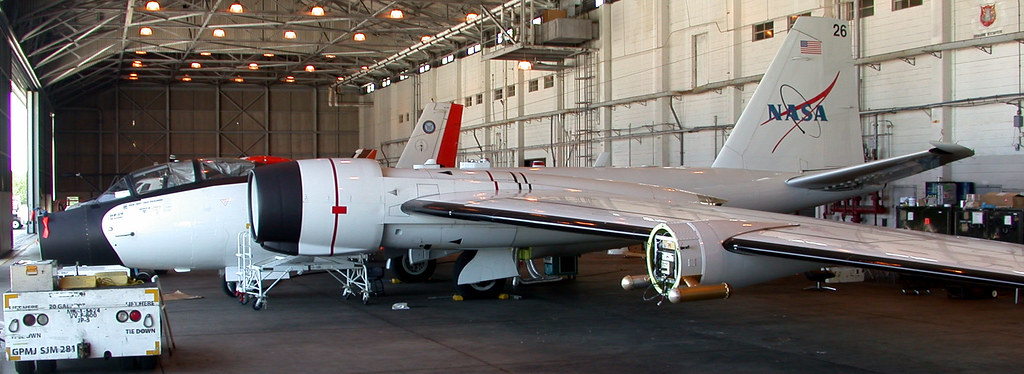The three former WB-57 bombers that NASA uses to capture solar eclipses
One of the news this Monday is a total solar eclipse, which occurs when the Moon comes between our planet and our star.
To capture this type of eclipses, NASA has three old Martin B-57 Canberra bombers, a type of aircraft that made its first flight in 1953 and served until 1983 in the United States Air Force. The B-57 was the American version of the British English Electric Canberra bomber, which made its first flight in 1949.

949 English Electric Canberra bombers were built in the United Kingdom and Australia and 403 B-57s in the United States. As a curiosity, the B-57 was the first jet bomber used in combat by the US to drop conventional bombs, specifically during the Vietnam War. In addition to 4 M-39 20 mm cannons, the Canberra had a large central weapons bay with the capacity to carry up to 2,000 kg of bombs. It could also carry nuclear bombs.

The Canberra was not only used as a bomber. There were also electronic countermeasures (ECM) and reconnaissance versions, and it was even used as an aggressor aircraft in exercises. One of the most sophisticated versions of the B-57 was the RB-57F, a version developed by General Dynamics from the B-57B bomber. The RB-57F's mission was to monitor nuclear bomb testing by making high-altitude atmospheric sampling and radiation detection flights. The service ceiling of the B-57B was 13,745 meters, but the RB-57F could fly up to a maximum altitude of 18,000 meters.

A total of 21 RB-57F were made (2 prototypes and 19 production aircraft), modified from B-57B bombers. Introduced in 1963, the RB-57F had a short career in the US Air Force (USAF), as it was retired from service in 1974.

In 1968, the USAF redesignated the RB-57F used in weather reconnaissance missions as the WB-57F (in theory, all USAF RB-57Fs had that mission as cover for their strategic reconnaissance missions). ) and made one of these aircraft available to NASA: 63-13501, reregistered as N925NA, with callsign NASA 925 and construction number M.266. Nicknamed "Rivet Rap", the aircraft was modified for use in multispectral sensor evaluation missions at a flight altitude close to space. This aircraft was retired from service in 1982 and today it is preserved in the Pima Air & Space Museum, in Tucson, Arizona. It is not exposed to the public, as it is without engines and without the nose section.

The USAF transferred three more WB-57Fs to NASA. They are as follows:
- 63-13503 (N926NA, NASA 926), originally a B-57B bomber (53-3974), was converted into an RB-57D reconnaissance aircraft in 1965. In 1994 it was delivered to the National Science Foundation, receiving civilian registration N357AR. It was sent to AMARC, the Davis-Monthan AFB aircraft graveyard, in 1996. In 2003 it was handed over to NASA for the High Altitude Research Program.
- 63-13295 (N927NA, NASA 927), originally a B-57B bomber (53-3918). Built in 1953, it was converted into an RB-57B in 1963. It was transferred to NASA in 2013, after spending many years at AMARC.
- 63-13298 (N928NA, NASA 928), originally a B-57B bomber (52-1536), was built in 1952 and converted to an RB-57F in 1966. It was assigned to the NASA in the 1970s.

These three aircraft remain active with NASA, being operated from the USAF Joint Reserve Base in Ellington, Texas, along with other NASA aircraft. These planes can be modified depending on the mission assigned to them, installing a telescope in the nose and various electronic systems in their bomb bay and in the four nacelles on the wings.

One of the missions of these planes is to capture eclipses for NASA. A few days ago, the US space agency explained the reason why he still uses these old planes for that purpose :
NASA’s WB-57s fly much higher than commercial aircraft. This altitude allows the jets to fly above clouds – meaning no chance of missing the eclipse due to bad weather. Additionally, the height puts the jets above most of Earth’s atmosphere, which allows for the cameras to take crisper images and capture wavelengths, such as infrared light, that don’t make it to the ground. Since the planes can travel at 460 miles per hour, they’re also able to extend the time they spend in the Moon’s shadow. While the eclipse will last no more than four and a half minutes at any point on the ground, the planes will see an eclipse that lasts about 25 percent longer, over 6 minutes and 22 seconds.

NASA used these planes to capture an eclipse for the first time in 2017. For this Monday's eclipse, NASA prepared three teams with as many WB-57s: "Two teams will image the Sun’s outer atmosphere – the corona – and a third will measure the ionosphere, the upper electrically charged layer of Earth’s atmosphere. This information will help scientists better understand the structure and temperature of the corona, the effects of the Sun on Earth’s atmosphere, and even aid in the search of asteroids that may orbit near the Sun."
---
Photos: NASA.
|
Don't miss the news and content that interest you. Receive the free daily newsletter in your email: |
- Most read
- The 'hole' without civil flights around Paris during the opening of the Olympic Games
- Stunning footage of the F-15QA Ababil in flight recorded from its cockpit
- The firearms used by the Pontifical Swiss Guard, the smallest army in the world
- The most distant deployment of the Spanish Air Force in Australia and New Zealand
- Eurofighter vs F-35: the opinions of professional pilots on these advanced fighters
- The first photo of an F-16 fighter with Ukrainian insignia and the details it has revealed
- This is the driver station of an M1 Abrams tank and the impressive start of its engine

 ES
ES







Opina sobre esta entrada: